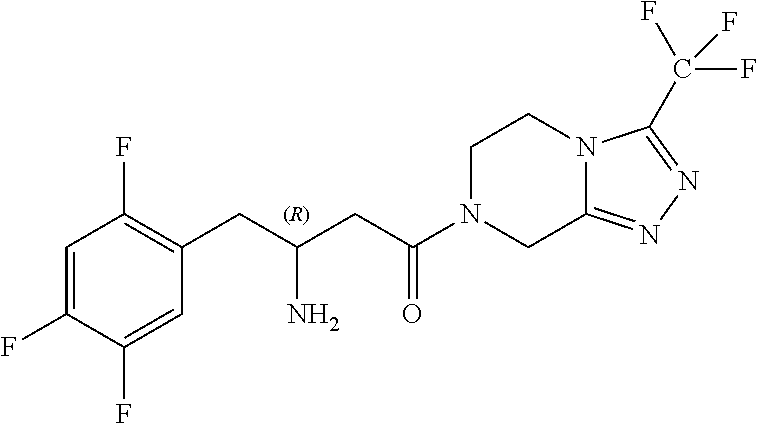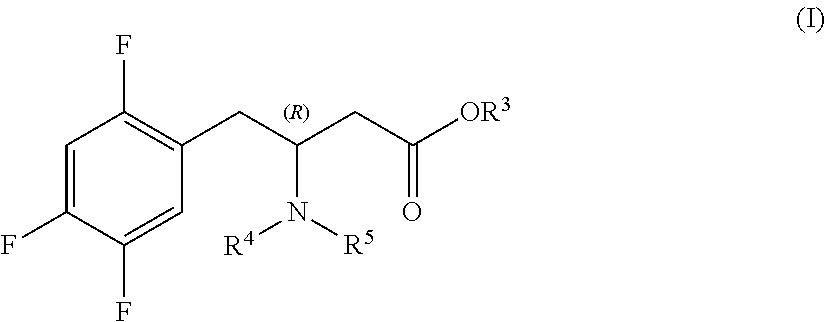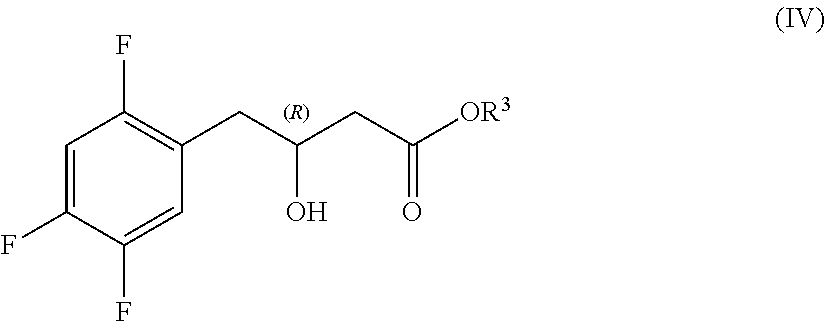Preparation of sitagliptin intermediates
- Summary
- Abstract
- Description
- Claims
- Application Information
AI Technical Summary
Benefits of technology
Problems solved by technology
Method used
Image
Examples
example 1a
Synthesis of (E)-methyl-4-(2,4,5-trifluorophenyl)-but-2-enoate (IIa) Through Grignard Exchange Reaction Followed by Iron Catalyzed Cross-Coupling Process
[0278]A dry and nitrogen-flushed 50 mL flask equipped with a magnetic stirrer and a rubber septum was charged with anhydrous THF (7 mL) and cooled to −20° C. Afterwards 2,4,5-trifluorobenzene (V) (22.2 mmol, 2.6 mL) was initiated through a septum following by slow addition of i-PrMgCl (2 M in THF, 1.20 equiv. according to (V), 13.3 mL). The slightly exothermic reaction occurred and reaction temperature rose to −10° C.
[0279]The reaction mixture was stirred for 2.5 hours, until the Br / Mg exchange reaction took place and (VI) was formed.
[0280]Into other three-necked dry flask flushed with nitrogen, were placed Fe(acac)3 (2.05 mmol, 10 mol % according to (V), 730 mg), TMEDA (4.1 mmol, 18 mol %, 620 μL) and hexamethylenetetramine (10 mol %, 287 mg). Anhydrous THF (15 mL) was added, the reaction mixture was cooled to 0° C. and vigorously ...
example 1b
Synthesis of (E)-methyl-4-(2,4,5-trifluorophenyl)-but-2-enoate (IIa) Through Grignard Exchange Reaction Followed by Cobalt Catalyzed Cross-Coupling Process
[0283]A dry and nitrogen-flushed 200 mL two-necked flask, equipped with a magnetic stirrer and a rubber septum was charged with anhydrous THF (20 mL) and cooled to −20° C. Afterwards 2,4,5-trifluorobenzene (V) (65.2 mmol, 13.7 g, 7.6 mL) was initiated through a septum following by slow addition of i-PrMgCl (2 M in THF, 1.2 equiv. according to (V), 39.6 mL). The reaction temperature was maintained at −10° C. and the reaction mixture was stirred for 3 hours, until Br / Mg exchange reaction was completed and (VI) was formed.
[0284]Into a three-necked dry flask flushed with nitrogen, were placed CoBr2 beads (3.76 mmol, 6 mol % according to (V), 822 mg, 99.99% purity), TMEDA (3.76 mmol, 6 mol %, 564 μL) and anhydrous THF (20 mL). Such reaction system was cooled to 0° C. and during intensive stirring methyl-trans-4-bromo-2-butenoate (VIIa)...
example 1c
Synthesis of (E)-methyl-4-(2,4,5-trifluorophenyl)-but-2-enoate (IIa) Through Grignard Exchange Reaction Followed by Co(acac)2 Catalyzed Cross-Coupling Process
[0285]A dry and nitrogen-flushed 200 mL two-necked flask, equipped with a magnetic stirrer and a rubber septum was charged with anhydrous THF (12.5 mL) and cooled to −20° C. Afterwards 2,4,5-trifluorobenzene (V) (25.35 mmol, 2.96 mL) was initiated through a septum following by slow addition of i-PrMgCl.LiCl complex (1.2 equiv. according to (V), 23.4 mL). The reaction temperature was maintained −10° C. and the reaction mixture was stirred for 1.5 hour, until Br / Mg exchange reaction was completed and (VI) was formed.
[0286]Into a three-necked dry flask flushed with nitrogen, were placed catalyst Co(acac)2 (1.40 mmol, 9 mol % according to (V), 360 mg, 99.99% purity), TMEDA (1.40 mmol, 9 mol %, 0.21 mL) and anhydrous THF (15 mL). Such reaction system was cooled to 0° C. and during intensive stirring methyl-trans-4-bromo-2-butenoate ...
PUM
| Property | Measurement | Unit |
|---|---|---|
| Electrophilic | aaaaa | aaaaa |
Abstract
Description
Claims
Application Information
 Login to View More
Login to View More - R&D
- Intellectual Property
- Life Sciences
- Materials
- Tech Scout
- Unparalleled Data Quality
- Higher Quality Content
- 60% Fewer Hallucinations
Browse by: Latest US Patents, China's latest patents, Technical Efficacy Thesaurus, Application Domain, Technology Topic, Popular Technical Reports.
© 2025 PatSnap. All rights reserved.Legal|Privacy policy|Modern Slavery Act Transparency Statement|Sitemap|About US| Contact US: help@patsnap.com



